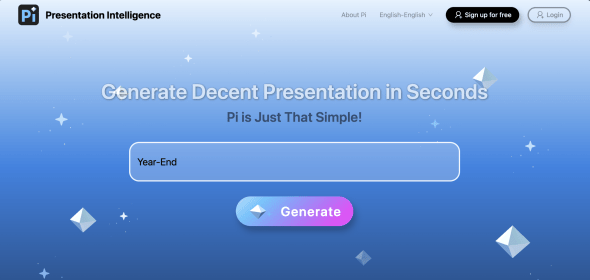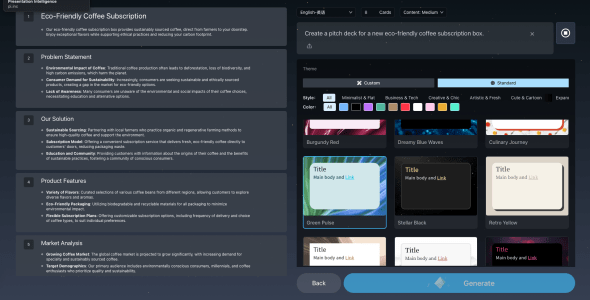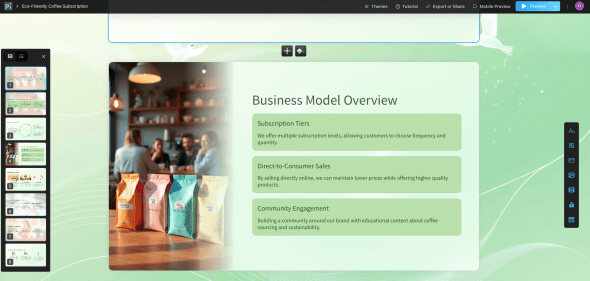Presentation Intelligence: Create a Professional Slide in Seconds
Presentation Intelligence is an AI-native platform that automatically generates professional presentations from user-provided content. Developed by a team of design and coding specialists, the tool was released around September 2024 to address common difficulties with traditional presentation software. It is particularly useful for professionals who lack design expertise or have limited time.
Presentation Intelligence targets a wide audience, including marketers, educators, startups, and designers. Its main function is to instantly turn raw text, documents, or web pages into visually coherent slide decks. The platform changes the conventional workflow by removing the need for manual formatting and template selection. The tool’s AI engine manages the entire design process, from layout to theme creation. This focus on speed and aesthetic quality makes it a notable entry in the AI presentation software market, especially as a presentation AI for free use at this time.
Best Use Cases of Presentation Intelligence
- Marketing and Sales Teams: Marketers can use Presentation Intelligence to rapidly create on-brand pitch decks and campaign reports. The tool helps solve the problem of inconsistent branding and time-consuming slide design. For example, a marketing manager can input a product brief and a link to their company’s website, and the AI will generate a complete presentation with appropriate branding and structure for a client meeting.
- Educators and Trainers: Teachers and corporate trainers need to produce engaging learning materials quickly. This platform helps them convert lesson plans or research papers into interactive and clear presentations. An educator could upload a PDF summary and receive a ready-to-use slideshow, freeing up time to focus on teaching.
- Startups and Entrepreneurs: Founders often need to create compelling pitch decks to secure funding. This tool allows them to generate professional-grade presentations without hiring a designer. An entrepreneur can outline their business plan in a text document, and the Slide AI will structure it into a persuasive narrative with strong visual appeal for investor meetings.
- Designers and Creators: Creative professionals can use Presentation Intelligence as a starting point for brainstorming and rapid prototyping. It helps overcome creative blocks by providing unique, AI-generated layouts that go beyond standard templates. A designer could use the tool to explore different visual directions for a client’s presentation before refining the final product.
Exceptional Speed: Presentation Intelligence generates complete, well-designed presentations from raw input in minutes, greatly reducing creation time.
Intuitive Interface: The platform is extremely user-friendly, making it accessible for users of all skill levels without a steep learning curve.
AI-Native Design: Instead of relying on fixed templates, the AI creates specific and context-aware designs for every deck creation task.
Helpful AI Interaction: The tool's AI is often praised for its conversational tone, making the creation process feel more collaborative.
Cost-Effective: As a presentation AI for free, the platform offers significant value for individuals and businesses on a budget.
Adaptive Content Framework: Presentations are built on a fluid framework that makes them look good on any device or screen size.
Versatile Input Options: Users can create presentations from text prompts, PDFs, Word documents, or even web page URLs for content summarization.
Limited Design Customization: While the automated designs are impressive, users have less granular control over individual elements compared to traditional software.
Potential for Contextual Errors: For highly specialized topics, the AI may occasionally misinterpret the content, requiring manual corrections.
Few Integrations: The tool currently lacks deep integrations with other business software, with PowerPoint export being the main option.
New to Market: As a newer tool, it may not have some of the advanced features and proven history of more established competitors.
-
AI-Powered Content Generation: Automatically creates presentation slides from simple text prompts.
-
Document-to-Presentation Conversion: Turns existing PDFs, DOCs, and PPTs into newly designed presentations.
-
Web Page-to-Presentation: Scrapes content from a URL to build a relevant slide deck.
-
Smart Editing and Layout: The AI engine intelligently structures content, suggests outlines, and arranges slide layouts.
-
Adaptive Themes: Offers a wide variety of customizable themes that the AI adapts to fit the presentation’s content and tone.
-
Fluid Content Framework: Makes presentations responsive and display correctly across desktops, tablets, and mobile devices.
-
Web-Based Sharing: Allows users to share presentations easily via a unique web link.
-
Slide AI for PowerPoint Export: Provides the option to download presentations in a standard PPT format, making it a useful slide ai for powerpoint users who want to edit offline.
-
Brand Alignment: Capable of incorporating brand colors and logos to maintain consistency.
-
AI-Assisted Outlining: Helps users structure their narrative by generating a logical outline from their initial input.
 Homepage Presentation Intelligence
Homepage Presentation Intelligence
 Presentation Intelligence Generator
Presentation Intelligence Generator
 Presentation Intelligences Slide
Presentation Intelligences Slide
Frequently Asked Questions
-
What does Presentation Intelligence do?
Presentation Intelligence is an AI tool that automatically creates complete, professionally designed presentations from text, documents, or web links. -
Who is the primary audience for this Slide AI?
The platform serves marketers, educators, startups, and anyone who needs to create high-quality presentations quickly. -
How is Presentation Intelligence different from PowerPoint?
Presentation Intelligence automates the design process using AI, whereas PowerPoint requires manual design and formatting. -
Is Presentation Intelligence a presentation AI for free?
Yes, currently, Presentation Intelligence is free to use. -
Can I export my presentations?
Yes, users can export presentations to the PowerPoint (PPT) format. -
Does it require any design skills?
No, the tool is designed for users with no prior design experience. -
How to make Slide AI?
Making a “Slide AI” presentation involves using a tool like Presentation Intelligence. Users provide content as text, a document, or a URL, and the AI automatically designs and generates the presentation slides. The process requires no manual design from the user. -
Which presentation AI is best?
The best presentation AI depends on your specific needs. Presentation Intelligence is a strong choice for users who need a fast, easy, and free tool to create professional slides quickly. For those needing strict brand control, Presentations.AI might be better, while Tome is excellent for interactive, web-based storytelling.
Tech Pilot’s Verdict on Presentation Intelligence
I have spent time digging into Presentation Intelligence to determine if this AI presentation maker delivers on its promise of effortless, high-quality slides. The AI tool category is crowded, so my goal was to see if it stands out.
My first test was to feed it a dense, text-heavy blog post about the future of AI in marketing. I provided the URL and let the Slide AI work. In under two minutes, I had a 15-slide presentation. The speed was genuinely impressive. It did a good job of extracting key headings, summarizing paragraphs into bullet points, and finding relevant stock images. The structure was logical. However, the design, while clean, felt a bit generic. This experience highlighted both its greatest strength (speed) and a key weakness (limited creative control).
Next, I tested the “from scratch” feature with the prompt: “Create a pitch deck for a new eco-friendly coffee subscription box.” Here, This slide agent performed better. The AI generated a solid outline, including slides for the problem, solution, market size, and business model. The tone was appropriate for a startup pitch. I could then edit the text, but the AI had already done most of the initial work.
Top Alternatives to Presentation Intelligence
-
Presentations.AI: Presentation.AI is a close competitor that focuses heavily on brand consistency. Its features ensure that every slide adheres to company guidelines, making it a better choice for large enterprises. While Presentation Intelligence offers more design flexibility per slide, Presentations.AI provides superior control for maintaining a unified corporate identity. It offers a free starter plan, but its Pro plan ($198/year) is for professional use.
-
Beautiful.ai: Beautiful.ai differentiates itself with an AI that acts as a set of guardrails to prevent users from creating poorly designed slides. It is less about generating a full presentation from a prompt and more about assisting you in making each slide correct. If you want more hands-on control without being a design expert, Beautiful.ai is an excellent choice. Its analytics are also a major plus for sales teams tracking viewer engagement.
-
Tome: Tome is more of a storytelling tool than a simple slide maker. Its tile-based system and integrations with platforms like Figma make it fitting for creating interactive, multimedia narratives. If your goal is a dynamic, web-based story rather than a traditional deck, Tome is the superior option. It is less suited for generating a quick slide ai for powerpoint and is better for creative, non-linear storytelling.
Final Verdict
After exploring its features, my verdict on Presentation Intelligence is positive, with some clear caveats. It is an outstanding tool for anyone who prioritizes speed and efficiency. For students, educators, and professionals in startups who need to produce good-looking presentations without spending hours on formatting, it’s a major time-saver. The fact that it’s a presentation AI for free makes it an unbeatable value proposition.
However, power users and professional designers may find the customization options too restrictive. If your role requires pixel-perfect control or deep analytics, alternatives like Beautiful.ai are likely worth the investment. Presentation Intelligence excels at getting you 90% of the way there in 10% of the time, and for many users, that is more than enough.

